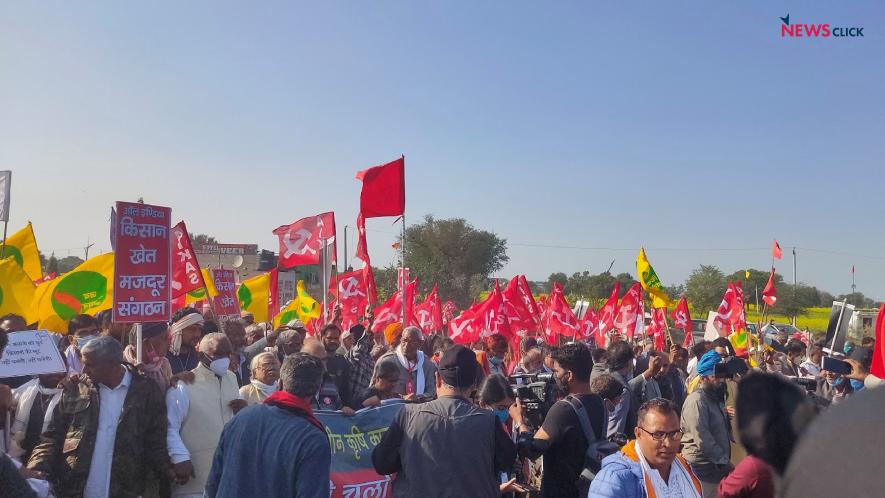Why Farmers are Protesting Electricity Amendment Bill, 2020

Farmers' Protest at Shahjahanpur, Haryana-Rajasthan border.
The farmers protesting the three Farm Acts are today in the 21st day of their struggle. Along with the Farm Acts, they are also demanding the rollback of the Electricity (Amendment) Bill 2020, proposed by the central government earlier this year. The Bill if passed, is likely to add Rs.1,00,000 crore additional burden on the farmers and an increase of 500% in their cost of irrigation. This is why the Electricity Act has also become a rallying point for the farmers, who are braving the bitter winter cold to camp at Delhi borders.
The proposed Amendment seeks to remove all cross-subsidies and make all consumers pay the actual cost of supply, or what the amendment calls the cost to serve the consumer. Currently the better-off consumers pay a higher rate, cross-subsidising the poor and the rural consumers. Under the proposed amendment, the farmers and the rural consumers will pay the highest price for electricity, as the cost of supply to rural areas are significantly higher than to urban consumers. And no prize for guessing who will pay the lowest price for electricity: it is the large enterprises and well-off consumers, who currently subsidise the poor and the rural consumers.
In this article, we are focussing on the implications for the farmers and not a detailed analysis of the proposed bill, which we have done earlier. The Farm Acts are a constitutional misadventure and a serious encroachment by the central government in what is a state subject. When it comes to the power sector, which is on the list of concurrent subjects, such encroachment has a long history and in the last few years it has increased to the extent that the proposed Electricity (Amendment) Bill, 2020, constitutes an egregious bid by the central government to “reform” the sector in favour of big capital and the rich, while leaving the state governments to deal with the financial and political consequences of its policies.
Since 1990, the main agenda of successive governments has been to try and break up the integrated electricity grid into generation, transmission and distribution, and privatise parts of it including the distribution companies, the DISCOMs. Barring a few exceptions (in some large cities), attempts to do so have failed.
While privatisation is hailed as the panacea for all that ails the distribution utilities, the inability to attract private capital in this sector is often attributed to the presence of cross-subsidies in the sector. Cross-subsidisation is a policy by which richer consumers pay more than the average cost of electricity to compensate for poorer consumers who pay lower than the average cost. Rural consumers, both agricultural and domestic, are the main beneficiaries of these subsidies. Since the Electricity Act, 2003, passed by the first NDA government before they lost the general election in 2004, the “elimination” of electricity subsidies has been on the agenda of the Bharatiya Janata Party. The first UPA government under the aegis of a Common Minimum Program, amended this provision in the 2003 Act to a “progressive reduction” of cross subsidies instead of their “elimination”.
Reversing that amendment with another one, the New Electricity (Amendment) Bill, 2020, proposes to eliminate cross-subsidies as they stand, in one go. The amendments mandate the State Electricity Regulatory Commissions to determine tariffs based on the “cost to serve” without allowing for any cross-subsidies. This means that each category of consumer, that is, agricultural, domestic, industrial etc. will pay what it costs to supply electricity to that category. If a state government wishes to subsidise any category of consumers, they may do so by transferring the subsidy benefits directly to the consumers by using the Direct Benefit Transfer (DBT) mechanism.
The first and most direct impact of this policy would be that rural consumers, especially agricultural consumers will be charged the highest tariffs. These consumers are the most expensive to serve, as supplying electricity to them requires long transmission and distribution lines and step-down transformers and there is therefore the additional cost of attendant line losses. On the other hand, large industrial consumers getting electricity through high-tension lines would have a lower tariff. One does not need complicated equations to surmise that this would be patently inequitable to begin with.
States would then have to identify and provide direct subsidies to consumers who need support, if they deem it necessary. This subsidy will be given directly by the state government to the intended beneficiary, but the beneficiary would have to pay the full cost raised in the bill to the distribution utility upfront, failing which the electricity connection could be terminated. Again, it does not need genius to predict the havoc this could wreak on the already precarious incomes of agricultural households.
Given the sorry state of state finances, to expect them to foot the bill for large sections of consumers in their states—peasants, working class households, small household-based enterprises, schools, public health centres, to name a few—without the benefit of cross-subsidies, will wreck state’s finances. With the Centre’s encroachment on almost all of the state’s revenue streams, especially since the implementation of the Goods and Services Tax (GST), and the repeated delays in releasing even the rightful share of the states, where will states find the money to subsidise consumers whose lives, jobs, and livelihoods depend on the availability of electricity? Electricity is not a luxury that rural consumers can do without and allows the farmers to provide us with food!
In 2018-19, the agricultural sector accounted for 22.4% of the total electricity sales in the country. The average cost of supply in the same year was Rs.6.13/unit. If farmers were to pay this cost, this would entail a revenue of about Rs.1,32,000 crore from agricultural consumers alone. Mind you, this is the average cost of supply, and not the cost to serve, which is even higher for rural areas. The proposed bill would therefore put a burden of over Rs.1 lakh crore per year on farmers. While a portion of this may be reimbursed, farmers will still have to bear this cost upfront while governments take their own time in transferring benefits to them.
If this amendment is enacted, a farmer operating a 5 hp pump-set for about four hours a day, twice a week for four months in a year, will have to pay around Rs.3,000 per year upfront in electricity bills. This constitutes a 500% increase in the cost of irrigation as compared to the current average cost. If higher water use is required due to erratic rains or a larger horsepower pump-set is required if the farm location is in an area with a lower water table, these costs would increase further. The impact will differ across states, but it would be uniformly terrible across the country on marginal and small peasants.
Of the total subsidy in the power sector in FY 2018-19, 55% was obtained through cross-subsidisation while the remaining was transferred by state governments to DISCOMs as direct subsidy. If cross-subsidies were to be removed overnight, and state governments were to foot the bill, it would entail a huge additional burden on them. Many state governments have therefore rightly opposed this Bill.
About the dubious Direct Benefit Transfer scheme, there are multiple issues that must be addressed. First is that since it will be the cash-strapped state governments that will transfer this amount to the beneficiaries, it is very likely that there will be delays and the individual consumers will face disconnection. Many of these consumers, especially the small and marginal peasantry, already under severe debt due to ever-increasing input costs and unremunerative prices for their produce, thus potentially face the loss of a critical input of electricity for their pump-set based irrigation.
Administering Direct Beneficiary Transfer schemes is difficult, as shown in many other sectors. Even when the identification of beneficiaries is relatively easy, such as in higher education for example, students have to wait for months at times to get their rightful scholarships, making it extremely difficult for many to continue their education. Multiple studies have shown the failure of the DBT scheme in the distribution of cooking gas where there is no guarantee that the money, even when transferred, will be available to women for the purchase of a gas cylinder. In the agriculture sector, the subsidy transfers will be to those who own land. Those cultivating leased land and sharecroppers are unlikely to be able to avail the benefits at all. In the case of food grains, studies show that the replacement of the public distribution system with the DBT scheme led to an increase in the market rates of food grains which were not accompanied by a commensurate increase in subsidy transfers. In the case of electricity too, unless direct subsidies are indexed to increases in electricity prices, it is likely to leave poor consumers in a lurch and eventually without access to electricity.
Finally, it is often argued that it is the rich peasants that benefit most from the subsidies and very little goes to the small and marginal peasants. This is not true. For example, in states like Andhra Pradesh and Telangana, over 40% of the ground water schemes are owned by marginal farmers, that is those who own less than 1 hectare of land, and another 50% are owned by small and semi-medium peasants, i.e. those owning between one to four hectares of land. In Punjab and Rajasthan, while the medium peasants, that is those owning between 4-10 hectares, own about 30-40% of the ground water schemes, over 40% of these schemes in both states are owned by small and semi-medium peasants owning between one to four hectares.
On the other hand, when it comes to surface water schemes, in Haryana and Punjab there is much higher ownership by medium and large peasants. However, surface water tariffs are highly subsidised and there is no discussion about revising these. But electric pump-set based ground water irrigation is sought to constantly be made more expensive.
More importantly, if the government were really worried about the landless, marginal, and small peasants, it would acknowledge that unequal access to benefits is the result of skewed land distribution and a lack of any serious land reforms in most parts of the country. However, addressing this is not even remotely on the agenda of the central government.
The presence of red flags across roads leading to Delhi have led many in the Government and media to characterize the ongoing protests as ideological and partisan. This characterisation omits that those who bulldozed the farm bills one after the other, without even a semblance of a democratic discussion, are also ideological and partisan. The difference is that one ideology stands for the rights of the peasantry and the working masses, and the other is pitted against them.
Tejal Kanitkar is associate professor and Juhi Chatterjee a research fellow, at NIAS, Bengaluru. The views are personal.
Get the latest reports & analysis with people's perspective on Protests, movements & deep analytical videos, discussions of the current affairs in your Telegram app. Subscribe to NewsClick's Telegram channel & get Real-Time updates on stories, as they get published on our website.























